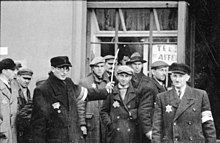



The Jewish Police Service (German: Jüdischer Ordnungsdienst), commonly known as Jewish Ghetto Police (German: Jüdische Ghetto-Polizei), also called the Jewish Police by Jews, were auxiliary police units organized within the Nazi ghettos by local Judenrat (Jewish councils).[1][2]
Overview
[edit]Members of the Jewish Police did not usually have official uniforms, often wearing just an identifying armband, a hat, and a badge, and were not allowed to carry firearms, although they did carry batons.[citation needed] In ghettos where the Judenrat was resistant to German orders, the Jewish police were often used (as reportedly in Lutsk) to control or replace the council.[3] One of the largest Jewish police units was to be found in the Warsaw Ghetto, where the Jüdischer Ordnungsdienst numbered about 2,500. The Łódź Ghetto had about 1,200, and the Lwów Ghetto had 500.[4]
Anatol Chari, a policeman in the Łodz Ghetto, in his memoirs describes his work protecting food depots, controlling bakery employees, as well as patrols aimed at the confiscation of food from the ghetto residents. He recounts the involvement of Jewish policemen in swindling food rations and in forcing women to provide sexual services in exchange for bread.[5] The Polish-Jewish historian and Warsaw Ghetto archivist Emanuel Ringelblum has described the cruelty of the ghetto Jewish police as "at times greater than that of the Germans, the Ukrainians and the Latvians."[6] The Jewish ghetto police ultimately shared the same fate with all their fellow ghetto inmates. On the ghettos' liquidation (1942–1943), they were either killed on-site or sent to extermination camps.[citation needed]
See also
[edit]References
[edit]- ^ Jarkowska-Natkaniec, Alicja (2013-08-28). "Jüdischer Ordnungsdienst in Occupied Kraków during the Years 1940-1945". Scripta Judaica Cracoviensia (in Polish). 11: 147–160. doi:10.4467/20843925SJ.13.013.1309. ISSN 2084-3925.
- ^ "Jewish Historical Institute, Polski Słownik Judaistyczny". www.jhi.pl. Retrieved 2020-09-05.
- ^ "Judischer Ordnungsdienst". Museum of Tolerance. Simon Wiesenthal Center. Archived from the original on 2009-03-05. Retrieved 2008-01-14.
- ^ Raul Hilberg: The Destruction of the European Jews, Quadrangle Books, Chicago 1961, p. 310.
- ^ Chari, Anatol (2012). Podczłowiek. Wspomnienia członka Sonderkommanda. Świat Książki. ISBN 978-83-7799-523-5.
- ^ Collins, Jeanna R. "Am I a Murderer?: Testament of a Jewish Ghetto Policeman (review)". Mandel Fellowship Book Reviews. Kellogg Community College. Retrieved 2008-01-13.
Further reading
[edit]- Anonymous (2014). The Clandestine History of the Kovno Jewish Ghetto Police. Indiana University Press. ISBN 978-0-253-01283-8.
- A Jewish Policeman in Lwow An Early Account, 1941-1943 Ben Z. Redner Translator: Jerzy Michalowicz (2015) ISBN 978-965-308-504-6